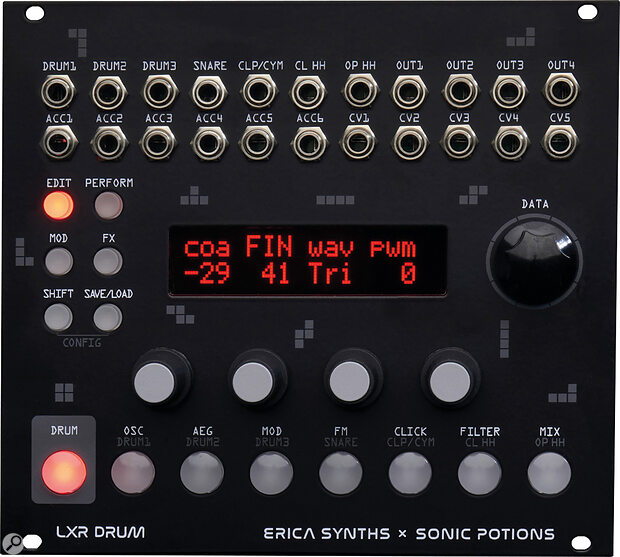I reviewed the Sonic Potions/Erica Synths LXR‑02 (note the extra zero) in the April 2022 issue. It’s a six‑voice digital drum machine with bags of character, and I enjoyed it greatly. So, when Erica Synths asked if we’d review the Eurorack module version (the LXR‑2), I jumped at the chance.
The LXR‑2 is a 28HP module with the same sound engine as the LXR‑02. There are six voices, although there are seven potential drum triggers. That’s because the open and closed hi‑hats share a voice. Each voice uses one of four synthesis algorithms: Drum, Snare, Cymbal/Clap and Hihats. You can have up to three Drum sounds and one each of the others. The algorithms combine elements of subtractive synthesis, FM, noise and samples (in a minimal way). The Drum algorithm is the most flexible and can be used to create just about any electronic drum sound you can imagine. The others are more targeted, with specific tailoring to create hi‑hats, cymbals, claps and snares. If you want more detail on each algorithm, see my original LXR‑02 review, but I will say that the synthesis on offer in the LXR machines is some of the best electronic drum synthesis on the market right now.
The desktop LXR‑02 had an integrated sequencer, but this has been dropped on the assumption that sequencing the Eurorack module will be external. In order to facilitate this, the LXR‑2 has seven pairs of trigger and accent inputs (5V). There are also five CV inputs (‑5V to +5V) and four audio outputs.
Workflow
The general workflow is something like this. You start by loading a kit from the micro SD card (the kit you had loaded at the last power cycle will load automatically). You select one of the seven drum slots using the Drum button together with one of the buttons along the bottom of the unit. You are then editing that drum. The same buttons also page around the synthesis option. The buttons are sensibly grouped so that you always go to the relevant page when you press, for example, the Filter button, regardless of which algorithm or voice you’re editing. It’s all very intuitive.
Everything revolves around the 2x20‑character OLED screen, which can display up to four parameters at once. It’s a small screen, so parameter names have to be shortened to just three characters. This can make deciphering them a bit cryptic, but a single click on the data encoder will expand the currently selected parameter to show you its full name.
The six buttons on the left of the unit manage navigation. There are two main modes, Edit and Perform. Edit is where we’ve been so far. Perform changes the bottom row of buttons to be used as triggers for the sound. Here, you can also set the Sound Morph function, select the Morph kit, and change the global sample rate.
Morphing is one of the LXR‑2’s most interesting features. Basically, you have two drum kits loaded into memory, and you can morph between them. This can be done via CV or LFO too. Morphing between two entirely different kits can be chaotic and amazing. For more subtle results, you can simply save two different versions of a kit and morph between those.
Speaking of CV control, there is a lot on offer. The Accent input for each voice controls its volume by default. You can disable this if required and add one additional parameter from almost all of the synthesis parameters available. Further to that, there are five CV inputs and six LFOs (one per voice). The CV inputs can be used for automation or to play any of the voices chromatically (up to five octaves). Each voice has a three‑slot modulation matrix. You can choose any Accent input, CV input or LFO as the source and any synthesis parameter from the current voice as a destination. The ability to use another voice’s accent input, or LFO, is quite brilliant.
The LFOs are cleverly designed too. Of course, all the usual stuff is there, but my favourite aspect is the ability to reset the phase of an LFO using any of the trigger inputs. Imagine, for example, having a percussion voice that uses an LFO to sweep the pitch, but the LFO is reset every time the kick drum is triggered.
Sounds can be routed to any of the four outputs or an effects bus. The outputs can be configured in any combination of stereo or mono. The effects are simple but sound surprisingly good. You can choose from one of four effects: drive, ring modulation, compression or delay. Overdrive is a common theme in the LXR, as there are many places you can push the gain for glue, overdrive, or outright destruction. And it sounds surprisingly analogue (it isn’t!).
The micro SD card is used to load and save kits and, if need be, update the firmware. My only wish is that you could also load and save individual drum sounds.
Verdict
The LXR sounds incredible. I think it might be my favourite drum machine from the past decade. It has a unique sonic signature, is deliciously electronic, and can produce anything: clean 808 sounds, filthy techno, FM bass, surprisingly realistic snares, a huge variety of hi‑hats and claps, and every conceivable laser, noise sweep or disco tom you could imagine.
The LXR‑2 isn’t a cheap module, but then you are getting a lot for your money. If you work out the cost‑to‑voice ratio, the value for money is excellent. You would struggle to find six drum voices for the same price in any other module or combination of modules. The LXR‑2 would make a brilliant centrepiece to a drum setup or could easily handle the drumming duties in a live rig — all whilst sounding magnificent. I love it!
£439
$509

